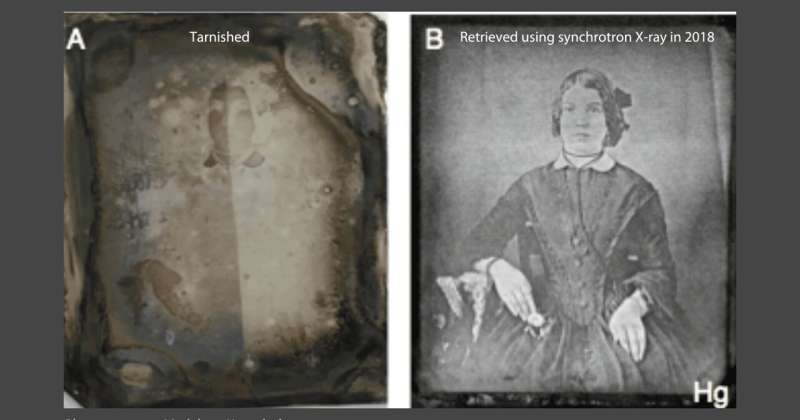Research revives 1800s photos

Researchers from Western University developed techniques for creating images from old, badly tarnished photographs. These techniques could also be used to study other historic artifacts and fossils and prevent corrosion in modern materials.
Chemistry professor Tson-Kong (T.K.) Sham and his colleagues recently confirmed a new synchrotron imaging technique they developed is just as effective for retrieving corroded daguerreotypes—the earliest form of photographs—as a strategy they first reported in 2018 and can also be used no matter how badly damaged the image surface is from natural corrosion or cleaning attempts.
The new research, which used beamlines at the Canadian Light Source (CLS) at the University of Saskatchewan, is published in the Journal of Cultural Heritage.
"This technique can be used widely in all walks of science, from looking at tissues to materials science," Sham said.
"You could determine whether or how a metal may be corrosion-resistant. Or in the case of an already corroded material, you can learn what the product of that corrosion is and its distribution on the surface, and then you can work back and think about how to prevent that corrosion from happening."
Sham said many applications are possible because synchrotron X-ray is very tunable, which means it can pick out any element and find out what its chemical surroundings are and where it is placed in the sample, even imaging it layer by layer.
When it comes to the conservation of antiques, Sham's research could be a game changer, especially for studying artifacts or fossils that have severe surface deterioration.
As part of his new research, he uncovered images of a man and woman fashionably dressed in mid-1850s garments and one of a baby wrapped in covers. All of these daguerreotypes, belonging to private collectors and the National Gallery of Canada, were badly damaged—slow deterioration mixed with cleaning attempts may have caused the tarnish.
Sham proved this synchrotron technique is always effective as long as the image particles underneath the tarnish remain intact, a discovery advancing his 2018 study in Scientific Reports. This research was done using the VESPERS and the SXRMB beamlines at the CLS and at the Advanced Photon Source at Argonne National Laboratory near Chicago.
"Revealing images that seemed lost forever is what's most exciting," Sham said. "We get a glimpse of people living in the 19th century that we wouldn't have otherwise and learn about their history and culture."
Each daguerreotype is unique—there are no negatives. Invented in 1839 and only popular for about 25 years, daguerreotypes are silver-coated copper plates treated with specific chemicals such as bromine gas to make them light-sensitive. Once placed in a camera, the cap would be removed to "impress" the image on the plates—a time-consuming process. Then, the plates would be treated with mercury vapor to fix the images permanently.
Sham's new research also showed the same X-rays that can help researchers "see" through the corrosion on the surface of daguerreotypes can also—indirectly—lead to damaging the plates.
"X-ray usually doesn't damage metals visibly, so I didn't think it would affect the plates, but perhaps chemical impurities or the corrosion itself on the daguerreotype got heated and left a small mark where the X-ray beam light went through," he said.
Sham recently returned to CLS for a follow-up study to learn how to preserve the plates. This ongoing research will investigate the chemical composition of the tarnish, and how glass covers and frames that store daguerreotypes could affect deterioration.
More information: Tsun-Kong Sham et al, Retrieving images from tarnished daguerreotypes using X-ray fluorescence imaging with an X-ray micro beam with tunable energy, Journal of Cultural Heritage (2024). DOI: 10.1016/j.culher.2024.02.003
Journal information: Scientific Reports
Provided by University of Western Ontario
No comments:
Post a Comment